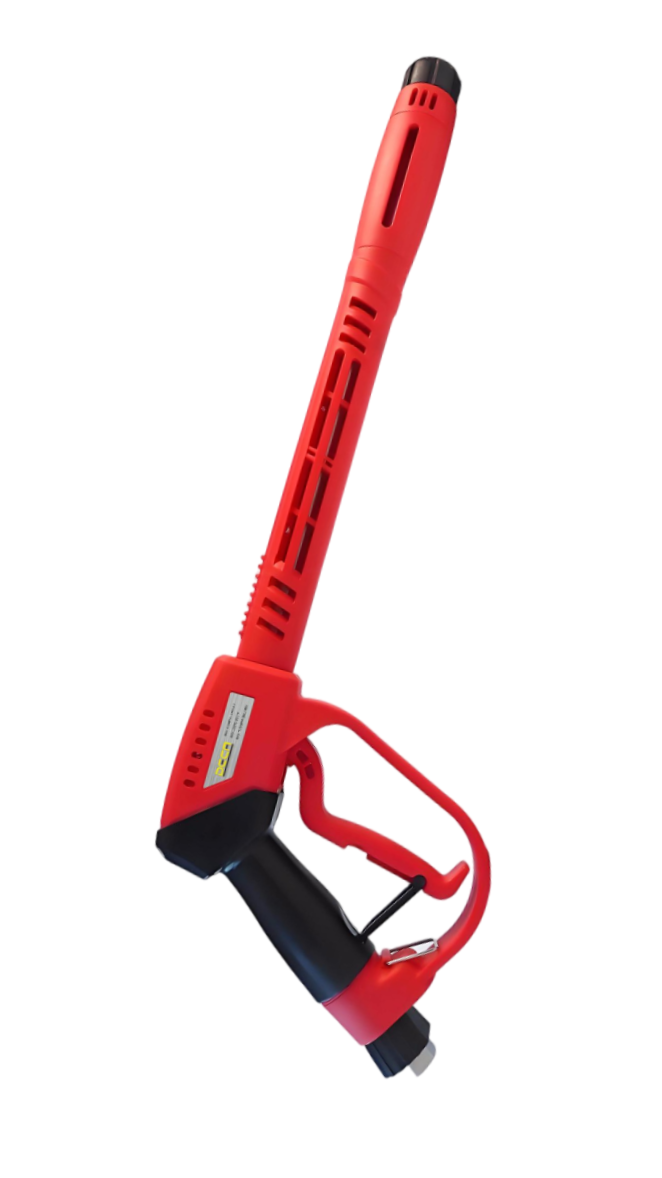Most of the user change spray guns frequently. It is not caused by damage, but due to poor maintenance.
By this article, you’ll learn how to keep your pressure washer gun in top shape and save money on replacements.
Understanding the Pressure Washer Spray Gun
First of all, let’s understand the key components of a typical trigger gun assembly. They are very important for effective cleaning and preventative maintenance. A standard pressure washer gun consists of the following parts:
Trigger: Controls the flow of water and pressure.
Lance: The extension tube connecting the gun to the spray wand.
Spray Wand: The nozzle assembly that produces the spray pattern. This is a crucial component that often requires regular cleaning.
Nozzles: These interchangeable tips create different spray patterns. These are particularly prone to clogging, requiring frequent checks and cleaning.
O-rings and Seals: These small components are the critical to prevent leaks. They can be found easily in a hardware store.
Quick Connect: They allow for easy attachment and detachment of the gun from the pressure washer hose.
Lifespan Differences Between Spray Gun Materials
1. Stainless Steel
Lifespan: Typically lasts over 5 years, depending on usage frequency and water quality.
2. Brass
Lifespan: Around 2–4 years. Commonly used in mid- to high-end residential or commercial spray guns.
3. Plastic
Lifespan: Around 1–2 years. Affordable and light in weight, suitable for low-pressure home use.
Quick Recommendation:
For commercial or industrial use → choose stainless steel.
For semi-professional or frequent home use → go with brass.
For occasional home use → plastic is sufficient.
Common Pressure Washer Spray Gun Problems
Most users on Amazon report leaks at the handle after 3–6 months of heavy use. The common cause are the following:
1. Trigger Jam
Cause: Worn spring, debris, or there is rust inside the trigger mechanism.
Fix: Replace the spring , O-rings or just clean the trigger pivot with lubricant, if the situation is not so bad.
2. Leaking
Cause: The O-rings/seals worn-out or the hose connections is loose.
Fix: Replace the O-rings/seals and ensure all the fittings of hose and gun are tightly secured.
3. Loss of Pressure
Cause: Clogged nozzle, damaged internal valve, or air intake problem.
Fix: Clean the nozzle, filter and replace the valve assembly if necessary.
Daily Maintenance for Pressure Washer Spray Guns
To keep your pressure washer spray gun working efficiently and extend its service life, regular maintenance is essential. Below are the key daily care steps, periodic checks, and storage precautions.
Daily Care (After Each Use)
1. Release the Pressure After Use
After turning off the washer, squeeze the trigger to release any remaining pressure and water inside the hose and gun.
In this way, we can prevents internal seals from being deformed under long-term pressure.
2. Drain Residual Water
Empty all water from the gun after cleaning to avoid rust or freezing damage—especially in winter.
3. Clean the Exterior and Nozzle
Rinse the gun body with clean water to remove mud, sand, or chemical residues. Use a pin or small brush to clear nozzle holes. This step will prevents clogging and ensures consistent spray patterns.
4. Dry and Lubricate
Wipe off moisture, then spray a light layer of anti-rust lubricant (e.g., WD-40) on the trigger and metal fittings. In this way, we can protect the spring and metal parts from rust and jamming.
Usage and Storage Tips
1. Avoid Dry Firing or Holding High Pressure for Too Long
2. Avoid Direct Sunlight and Freezing Conditions
3. Rinse After Using Detergents
4. Store in a Cool, Dry Place
How Often Should You Maintain It?
Light household use : 1–2 times per week
A simple maintenance check once a month is sufficient.
Commercial or industrial use : Daily operation
Inspect weekly, perform full maintenance monthly, and replace seals every six months.
High-temperature, chemical, or humid environments: half of the standard schedule
Storage and Long-Term Care
· Drain All Water After Use
· Keep It in a Dry, Ventilated Area
· Avoid Direct Sunlight and Extreme Temperatures
· Use a Protective Cover or Case
· Disconnect All Hoses and Fittings
· Apply Light Lubrication Before Long-Term Storage
· Keep Away from Children and Direct Impact
When to Replace Instead of Repair?
1. Cracked or Leaking Gun Body
2. Severe Internal Corrosion or Rust
3. Worn-Out Trigger Mechanism
4. Persistent Leaks After Seal Replacement
5. Reduced Pressure or Inconsistent Spray Pattern
6. Aging Plastic Components
Pro Tips from Experts
Always use compatible fittings (M22 or Quick-Connect)

Avoid using acid or strong solvents during cleaning
Check PSI and GPM ratings before replacement
Looking for a durable replacement spray gun? Check out our stainless steel models designed for both home and commercial use.




